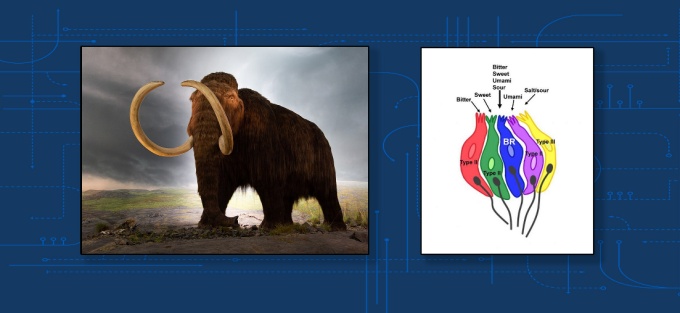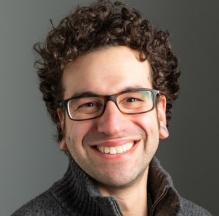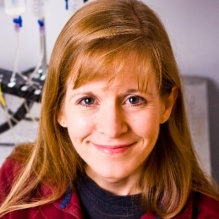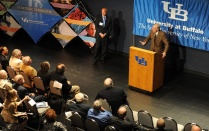Two of 2020's top twenty research stories feature the work of our faculty

Two of 2020's top twenty research news stories feature the work of our faculty.
In a difficult year, UB faculty, staff and students continued to break ground in fields that ranged from biology and climate science to history and design. Through discoveries large and small, UB’s physicians, chemists, geologists, writers, historians, sociologists and engineers engaged in a vital, shared mission: to learn about the world around us, and to make it better. These research findings are just a few examples of the knowledge that UB scholars contributed to the world in 2020. In a wrap-up of 2020's top research news, reporters Charlotte Hsu and Cory Nealon selected research by Vincent Lynch and Kathryn Medler, as two of the year's top twenty research stories.

Vincent J. Lynch, PhD
A new kind of taste cell
What doomed the last woolly mammoths? A study led by UB evolutionary biologist Vincent Lynch provides insight into this question. The research examined genetic mutations in a mammoth from Wrangel Island, thought to be the last place on Earth where the creatures survived. The team synthesized the mammoth’s broken genes in the lab to test whether they functioned normally. They did not. Genetic defects may have hindered the animals’ development, reproduction and sense of smell, the study concluded. “The take-home message is that the last mammoths may have been pretty sick and unable to smell flowers,” Lynch says.
International news features:

Kathryn Medler, PhD
A new kind of taste cell
In a new study, UB scientists identified multitasking taste cells that can detect bitter, sweet, umami and sour stimuli. The discovery upended conventional notions of how taste works. In the past, it was thought that taste cells were highly selective, capable of discerning only one or two types of the five basic stimuli (only sweet, for instance, or only salty and sour). “This changes the way we’ve been thinking about how taste cells function,” says UB biologist Kathryn Medler, who led the project with UB PhD graduate Debarghya Dutta Banik (now at Indiana University) and UB psychology researchers Ann-Marie Torregrossa and Greg Loney.
International news features:
Research News
Twenty UB research stories from 2020
Researchers developed a new biometric approach that uses 3D images of finger veins. Shown are finger vessel images from eight different subjects, with colors that represent different depths. Image: Jun Xia
By CHARLOTTE HSU and CORY NEALON
Published January 5, 2021
The veins in a person’s fingers could act as a biometric password. Age discrimination laws may not protect women as well as they do men. The last woolly mammoths on Earth, living on a lonely Arctic island, may have been unable to smell the flowers they ate.
These research findings are just a few examples of the knowledge that UB scholars contributed to the world in 2020.
In a difficult year, UB faculty, staff and students continued to break ground in fields that ranged from biology and climate science to history and design. Through discoveries large and small, UB’s physicians, chemists, geologists, writers, historians, sociologists and engineers engaged in a vital, shared mission: to learn about the world around us, and to make it better.
They studied the novel coronavirus and its deep impacts on society. They tested new materials for transistors. They explored the psychological benefits of guilty pleasures. Cecil Foster, professor of transnational studies, consulted on a major forthcoming TV series inspired by his book, “They Call Me George: The Untold Story of Black Train Porters and the Birth of Modern Canada.”
Here are a few UB stories that made headlines in 2020.
History | The extraordinary life of Mary Talbert
Mary B. Talbert oval portrait. Photo courtesy of The Buffalo History Museum.
For over 40 years, UB historian Lillian S. Williams has been documenting and celebrating the life of Mary Burnett Talbert, an early 20th-century civil rights reformer, suffragist and human rights advocate from Buffalo. In a year of mass protests for racial justice, Williams connected Talbert’s efforts to today’s Black Lives Matter movement. Then as now, it is the same fight, Williams said, “a persistent struggle to dismantle systemic racism and to improve life.” In the summer, UB renamed a major campus road after Talbert, replacing the name of a former chancellor who held racist views. Remarking on the change, Williams said, “Mary Talbert Way will be a constant reminder of her vision, diligence and commitment to social justice.”
As featured in:
Evolution | The end of woolly mammoths
What doomed the last woolly mammoths? A study led by UB evolutionary biologist Vincent Lynch provides insight into this question. The research examined genetic mutations in a mammoth from Wrangel Island, thought to be the last place on Earth where the creatures survived. The team synthesized the mammoth’s broken genes in the lab to test whether they functioned normally. They did not. Genetic defects may have hindered the animals’ development, reproduction and sense of smell, the study concluded. “The take-home message is that the last mammoths may have been pretty sick and unable to smell flowers,” Lynch says.
As featured in:
Biometrics | Finger veins
Researchers developed a new biometric approach that uses 3D images of finger veins. Shown are finger vessel images from eight different subjects, with colors that represent different depths. Photo: Jun Xia
Researchers developed a new biometric approach that uses 3D images of finger veins. Shown are finger vessel images from eight different subjects, with colors that represent different depths. Credit: Jun Xia
Biometric authentication uses anatomical features such as fingerprints or facial features to verify a person’s identity. What’s next for this field? The veins in your fingers, according to UB biomedical engineering researcher Jun Xia. He led a study that described how 3D images of finger veins could boost digital security.
As featured in:
Mental health | Benefits of guilty pleasures
Shira Gabriel.
Watching reruns or listening to a favorite musician can create a sense of belonging, UB psychology researchers say. In a study, they found that non-traditional social strategies can help to fulfill critical social needs — a welcome bit of news as individuals struggled with loneliness under quarantine. “I don’t think people realize that these non-traditional connections are as beneficial as we found in our research,” says Shira Gabriel, who authored the paper with Elaine Paravati Harrigan (now at Hamilton College) and Esha Naidu.
As featured in:
Aging | Discrimination laws and older women
Joanne Song McLaughlin.
Age discrimination laws don’t protect older women as they do older men, according to an analysis by UB economist Joanne Song McLaughlin. “These women are falling through the cracks,” McLaughlin says. She adds that the research findings point to the need for more protections for older women, who face both age and gender discrimination. “Older women’s intersectional discrimination must be recognized as a separate cause of action,” she says.
As featured in:
Biology | A new kind of taste cell
Most taste cells selectively respond to a specific stimulus type while broadly responsive cells respond to multiple taste qualities. Image: Jhanna Flora and Kathryn Medler
In a new study, UB scientists identified multitasking taste cells that can detect bitter, sweet, umami and sour stimuli. The discovery upended conventional notions of how taste works. In the past, it was thought that taste cells were highly selective, capable of discerning only one or two types of the five basic stimuli (only sweet, for instance, or only salty and sour). “This changes the way we’ve been thinking about how taste cells function,” says UB biologist Kathryn Medler, who led the project with UB PhD graduate Debarghya Dutta Banik (now at Indiana University) and UB psychology researchers Ann-Marie Torregrossa and Greg Loney.
As featured in:
#SciComm | Diversity in STEM
Raven Baxter.
In 2020, Fortune named Raven Baxter — also known as Raven the Science Maven — to the magazine’s “40 Under 40” list for health care. A science communicator and molecular biologist, Baxter champions diverse spaces in STEM. During the pandemic, her science-themed music video “Wipe It Down” has helped to spread the word about ways to prevent COVID-19. The recording has been viewed over 33,000 times on YouTube. Baxter’s myriad achievements in 2020 also included founding Black in Science Communication, securing a TV deal for a science education show, continuing her work with the STEMbassy web series she founded, and pursuing her PhD in the UB Graduate School of Education. Her dissertation focuses on culturally responsive teaching strategies in STEM education.
As featured in:
- Fortune 40 Under 40: Raven Baxter
- BuzzFeed: Raven the Science Maven, a molecular scientist and PhD student, makes music videos to empower women in STEM
- WKBW-TV: Raven the Science Maven spreading knowledge through music
- WIVB-TV: Buffalo’s Raven the Science Maven named top 40 under 40 by Fortune Magazine
- Science News: Meet 5 Black researchers fighting for diversity and equity in science
Buildings | A universally designed hotel
The recently opened Hampton Inn Buffalo-Amherst hotel across from UB's North Campus is one example of how UB's IDEA Center has worked with the business sector on inclusive design.
The recently opened Hampton Inn Buffalo-Amherst hotel across from UB's North Campus is one example of how UB's IDEA Center has worked with the business sector on inclusive design.
In a year that challenged the hospitality industry, the opening of a Hampton by Hilton in Amherst marked a rare bright spot. The hotel is the nation’s first to receive isUD™ (innovative solutions for Universal Design) certification, an inclusive standard that empowers diverse populations by creating spaces and products that can be easily used by people with a wide range of ages and abilities. UB’s Center for Inclusive Design and Environmental Access (IDEA Center) partnered with Uniland on the project and has led efforts to make universal design a standard practice, creating a more inclusive world.
As featured in:
- The Buffalo News: Rare hotel featuring inclusive design opens in Amherst
- WBFO: Inclusive, first-of-a-kind hotel opens in Amherst
- WIVB-TV: New Hampton Inn in Amherst not only first of its kind in WNY, but across the country
- New York Real Estate Journal: Uniland opens $14.4 million Hampton Inn Buffalo-Amherst
Medicine | Prescriptions and older adults
In the U.S., over 34% of people who are 65 and older are prescribed potentially inappropriate drugs, according to a study led by UB pharmacy researchers Collin Clark and David Jacobs. As the country’s population ages, “Harm to older adults caused by potentially inappropriate medications is a major public health challenge,” Clark says. Damaging side effects and higher health care costs are just two of the many problems that can result from inappropriate prescriptions.
As featured in:
- U.S. News and World Report: One-third of older Americans are prescribed drugs they may not need
- Consumer Affairs: Nearly 35 percent of adults are prescribed inappropriate drugs, study finds
- WebMD: 1 in 3 U.S. seniors prescribed inappropriate drugs
- Atlanta Constitution-Journal: Study: 34% of older U.S. adults prescribed potentially inappropriate drugs
COVID-19 | Childhood obesity
Myles Faith
Pandemic lockdowns can negatively impact diet, sleep and physical activity among kids with obesity. A study of 41 children in Italy found that the children ate an additional meal per day during a period of confinement, compared with a year before. They also slept an extra half hour per day, added nearly five hours per day in front of screens and consumed more red meat, sugary drinks and junk foods. Myles Faith, UB chair of counseling, school and educational psychology, co-authored the research.
As featured in:
- Moms.com: COVID-19 lockdown is negatively impacting kids struggling with obesity
- Syracuse Post-Standard: Obesity expert: Make small changes to ward off quarantine weight gain
- The Economist: Lockdowns could have long-term effects on children's health
- CNN: Sedentary lockdowns put kids at risk for obesity. Here's how to help them stay moving
COVID-19 | Fear of the ER?
E. Brooke Lerner
Early on in the pandemic, calls for emergency medical services (EMS) fell in the U.S., according to a study led by UB emergency medicine expert E. Brooke Lerner. Meanwhile, the rate of EMS-attended deaths doubled. The findings suggest that “people who need emergency health care may be delaying care such that their lives are actually in jeopardy,” Lerner says. Patients may put off calls because they fear contracting COVID-19 in health care facilities, or because they don’t want to burden hospitals. The findings point to a need for public health messaging that stresses the importance of seeking care for serious concerns, Lerner says. The study was one of many that UB researchers conducted on the novel coronavirus and its societal impacts during a challenging year.
As featured in:
Politics | A polarized nation
James Campbell.
Most political pundits predicted a decisive victory for Joe Biden and the Democratic Party this fall. Not veteran UB political scientist James Campbell, whose election model forecasts showed in September that the race was too close to call. This finding, as well as his prediction the Republican Party would gain House seats, proved accurate. The ballot also showed a deeply polarized nation, another topic Campbell researches.
As featured in:
Elections | Toward authoritarianism?
James Gardner
UB law professor James Gardner is one of the nation’s preeminent election law scholars. He is concerned that the nation, particularly actions taken by President Donald Trump and the Republican Party, may be sliding toward authoritarianism. His research suggests this pivot is happening in states as well as the judicial system. “In light of these considerations, it seems to me that any return in the United States to the kind of stable, reliable, consensual liberal democracy that prevailed during the last half of the twentieth century is uncertain and, at best, a long way off,” Gardner writes.
As featured in:
- ABC News: Trump’s efforts to flip Michigan election results raise significant legal, ethical questions
- The Washington Post: Disarray and defeats mark post-election period as Trump struggles to govern and fails to change vote results
- CBC: How long can vote counting go on for? Your U.S. election questions answered
- Al Jazeera: ‘Counting ballots is not fraud’: Experts blast Trump claims
Great Lakes | Legacy pollutants in birds
Diana Aga
Long-banned chemicals continue to threaten Great Lakes wildlife. A study found PCBs, PBDEs and metabolites of DDT in the organs of common terns along the Niagara River and Lake Erie shore. These pollutants have not been produced in the U.S. for years or decades. The findings highlight the urgency of protecting the environment as problems surrounding other persistent chemicals, such as PFAS, emerge. UB chemists Diana Aga and Steven Travis conducted the study with SUNY Buffalo State biologist Alicia Pérez-Fuentetaja.
As featured in:
- Michigan Radio: Long-lasting pollutants harming some Great Lakes shorebirds
- Great Lakes Now: Legacy pollutants continue to haunt the Great Lakes
- Environmental Health News: Long-banned toxics are still accumulating in Great Lakes birds — as new chemical threats emerge
- Technology Networks: Legacy pollutants still turning up in migratory birds
Women’s health | Get moving
“Sit less, walk more for heart health.” That, says UB public health researcher Michael LaMonte, is the takeaway from two recent studies on women’s health. In one, UB epidemiologist Connor Miller and colleagues found that participants who met the physical activity guideline of 30 minutes per day of moderate activity exclusively through walking had a lower risk of developing hypertension. In the second — a study of more than 80,000 postmenopausal women aged 50 to 79 — researchers report that more time spent sedentary while awake is associated with higher risk of heart failure hospitalization. “Walking and moving are simple activities that can be easily integrated into our daily lives,” says Jean Wactawski-Wende, dean of the UB School of Public Health and Health Professions, a co-author of both papers.
As featured in:
Health | Treating diabetes
Teresa Quattrin
Groundbreaking discoveries by UB medical researchers are improving diabetes treatment. In a study led by UB pediatric endocrinologist Teresa Quattrin, a drug called golimumab reduced the amount of injected insulin required by children and young adults with newly diagnosed Type 1 diabetes, among other benefits. Separately, research co-authored by UB endocrinologist Paresh Dandona showed that testosterone therapy can lead to remission in men with Type 2 diabetes.
As featured in:
Health | Obesity and income
A study analyzing 40 years of data across 147 countries showed that around the world, obesity rises along with national income. “As most people currently live in low- and middle-income countries with rising incomes, our findings underscore the urgent need for effective policies to break — or at least weaken — the relationship between income growth and obesity,” says co-author Debabrata Talukdar, a UB School of Management researcher.
As featured in:
- U.S. News & World Report: As a nation’s worth grows, so do waistlines
- UPI: As national wealth grows, so do obesity rates, study says
- Medical Xpress: New insights into links between national income and obesity
Electronics | Paper-thin transistors
Transistors crafted from gallium oxide could lead to smaller systems for controlling and converting electric power in electric cars, locomotives and airplanes. A study led by UB electrical engineer Uttam Singisetti found that paper-thin electronic switches can handle 8,000 volts. Co-authors include past and current members of Singisetti’s lab: Sudipto Saha, Shivam Sharma and Ke Zeng. Advances in transistor technology could up the distance that electronic vehicles can travel.
As featured in:
- IEEE Spectrum: Super-high-voltage gallium oxide transistors could transform power electronics
- New Atlas: Ultra-high voltage transistors aim to boost EV range and efficiency
- Engineering.com: Thin as paper, new transistor handles 8,000 volts
- EE Power: Researchers develop paper-thin gallium oxide transistor
Climate change | Earth’s melting ice
The edge of the Greenland Ice Sheet. Photo: Jason Briner
UB climate scientists co-authored two major studies that underscore the urgent need for societies to curb carbon emissions. First, a large international team leveraged UB’s supercomputing facilities to generate new estimates showing that Earth’s shrinking ice sheets could add over 15 more inches to sea level rise by 2100. Sophie Nowicki, a NASA ice scientist who joined UB this fall, coordinated that effort. In a separate project, researchers combined field work and ice sheet modeling to show that Greenland is on track to lose ice faster this century than in any century over the past 12,000 years. “We’ll blow that out of the water if we don’t make severe reductions to greenhouse gas emissions,” says UB geologist Jason Briner, who led the research.
As featured in:
- Live Science: Melting ice sheets will add over 15 inches to global sea level rise by 2100
- CBS News: Greenland is losing ice at the fastest rate since the collapse of the last Ice Age, scientists say
- Scientific American: Greenland is melting faster than any time in past 12,000 years
- Nature News: Greenland's ice will melt faster than any time in the past 12,000 years
- Carbon Brief: Greenland to lose ice far faster this century than in the past 12,000 years
History | Black train porters and civil rights
Cecil Foster
In December, CBC and BET+ announced production of a TV series that will tell the story of Black train porters in Canada and the U.S., a history documented in UB scholar Cecil Foster’s 2019 book, “They Call Me George: The Untold Story of Black Train Porters and the Birth of Modern Canada.” The television drama will follow “the journeys of four ambitious souls who hustle, dream, cross borders and confront barriers in the fight for liberation — on and off the railways that crossed North America,” according to a news release. Foster, a consultant on the project, meets with the writing team, comments on scripts, confirms historical accuracy and suggests plot lines. The porters provided service in luxury sleeping cars where passengers, unwilling to learn the porters’ names, called anyone holding that position “George.” Foster’s book preserves these workers’ stories for future generations, drawing on interviews with retired porters to detail how their struggle against racism advanced civil rights and multiculturalism.
As featured in:
- CBC: CBC and BET+ team up to greenlight 'The Porter'
- NOW Magazine: CBC’s The Porter will be Canada’s biggest Black-led TV series
- Deadline: CBC, BET+ team on ‘The Porter’ railway workers drama
- Toronto Star: CBC and BET Plus partner on ‘The Porter,’ depicting 1920s Little Burgundy in Montreal
- Oral History Review: 5 questions about “They Call Me George: The Untold Story of The Black Train Porters




















